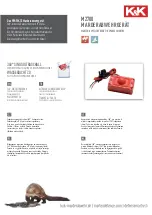
GE Multilin
B30 Bus Differential System
4-17
4 HUMAN INTERFACES
4.3 FACEPLATE INTERFACE
4
Figure 4–19: LED PANEL 1
STATUS INDICATORS:
•
IN SERVICE
:
Indicates that control power is applied; all monitored inputs/outputs and internal systems are OK; the
relay has been programmed.
•
TROUBLE
: Indicates that the relay has detected an internal problem.
•
TEST MODE
:
Indicates that the relay is in test mode. For more information, see the Test Mode section in the Settings
chapter.
•
TRIP
:
Indicates that the selected FlexLogic operand serving as a Trip switch has operated. This indicator always
latches; the reset command must be initiated to allow the latch to be reset.
•
ALARM
:
Indicates that the selected FlexLogic operand serving as an Alarm switch has operated. This indicator is
never latched.
•
PICKUP
:
Indicates that an element is picked up. This indicator is never latched.
EVENT CAUSE INDICATORS:
Events cause LEDs are turned on or off by protection elements that have their respective target setting selected as either
“Enabled” or “Latched”. If a protection element target setting is “Enabled”, then the corresponding event cause LEDs
remain on as long as operate operand associated with the element remains asserted. If a protection element target setting
is “Latched”, then the corresponding event cause LEDs turn on when the operate operand associated with the element is
asserted and remain on until the RESET button on the front panel is pressed after the operand is reset.
All elements that are able to discriminate faulted phases can independently turn off or on the phase A, B, or C LEDs. This
includes phase instantaneous overcurrent, phase undervoltage, etc. This means that the phase A, B, and C operate oper-
ands for individual protection elements are ORed to turn on or off the phase A, B, or C LEDs.
•
VOLTAGE
: Indicates voltage was involved.
•
CURRENT
: Indicates current was involved.
•
FREQUENCY
: Indicates frequency was involved.
•
OTHER
: Indicates a composite function was involved.
•
PHASE A
: Indicates phase A was involved.
•
PHASE B
: Indicates phase B was involved.
•
PHASE C
: Indicates phase C was involved.
•
NEUTRAL/GROUND
: Indicates that neutral or ground was involved.
USER-PROGRAMMABLE INDICATORS:
The second and third provide 48 amber LED indicators whose operation is controlled by the user. Support for applying a
customized label beside every LED is provided.
User customization of LED operation is of maximum benefit in installations where languages other than English are used to
communicate with operators. Refer to the
User-programmable LEDs
section in chapter 5 for the settings used to program
the operation of the LEDs on these panels.
PICKUP
ALARM
TRIP
TEST MODE
TROUBLE
IN SERVICE
STATUS
USER 3
USER 2
USER 1
RESET
NEUTRAL/GROUND
PHASE C
PHASE B
PHASE A
OTHER
FREQUENCY
CURRENT
VOLTAGE
EVENT CAUSE
842781A1.CDR
Summary of Contents for B30 UR Series
Page 10: ...x B30 Bus Differential System GE Multilin TABLE OF CONTENTS ...
Page 122: ...4 30 B30 Bus Differential System GE Multilin 4 3 FACEPLATE INTERFACE 4 HUMAN INTERFACES 4 ...
Page 326: ...5 204 B30 Bus Differential System GE Multilin 5 10 TESTING 5 SETTINGS 5 ...
Page 412: ...A 12 B30 Bus Differential System GE Multilin A 1 PARAMETER LISTS APPENDIX A A ...
Page 554: ...D 10 B30 Bus Differential System GE Multilin D 1 IEC 60870 5 104 APPENDIX D D ...
Page 566: ...E 12 B30 Bus Differential System GE Multilin E 2 DNP POINT LISTS APPENDIX E E ...
Page 574: ...F 8 B30 Bus Differential System GE Multilin F 3 WARRANTY APPENDIX F F ...
















































